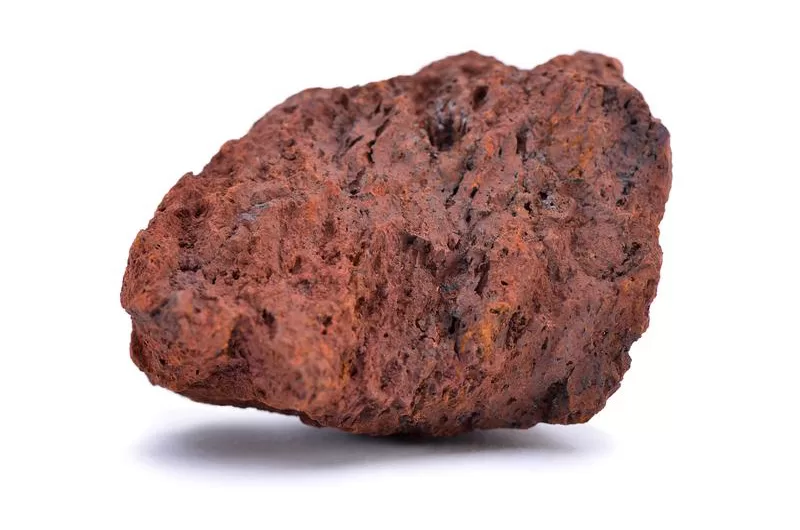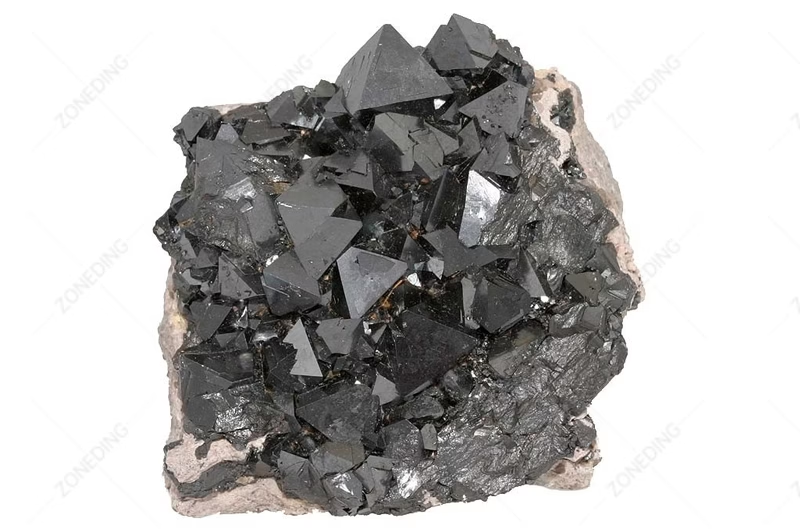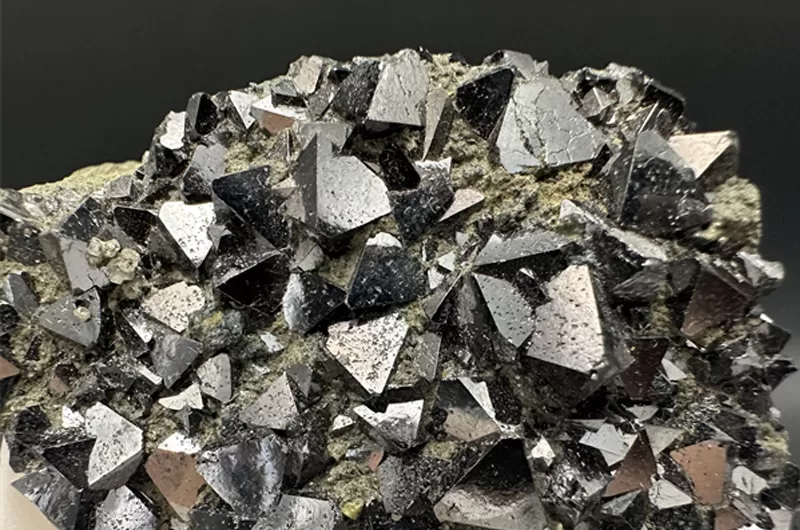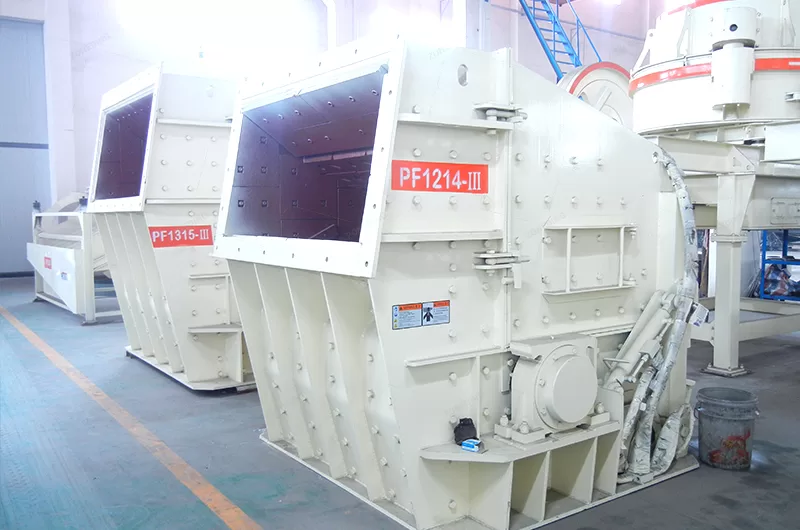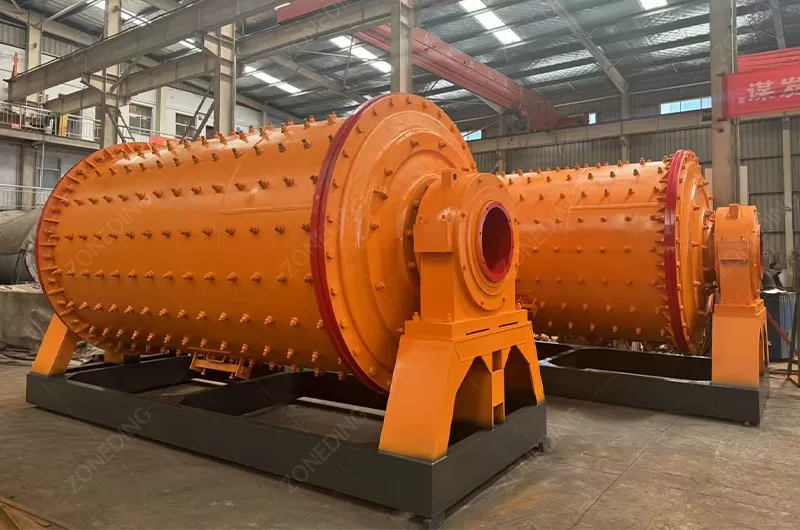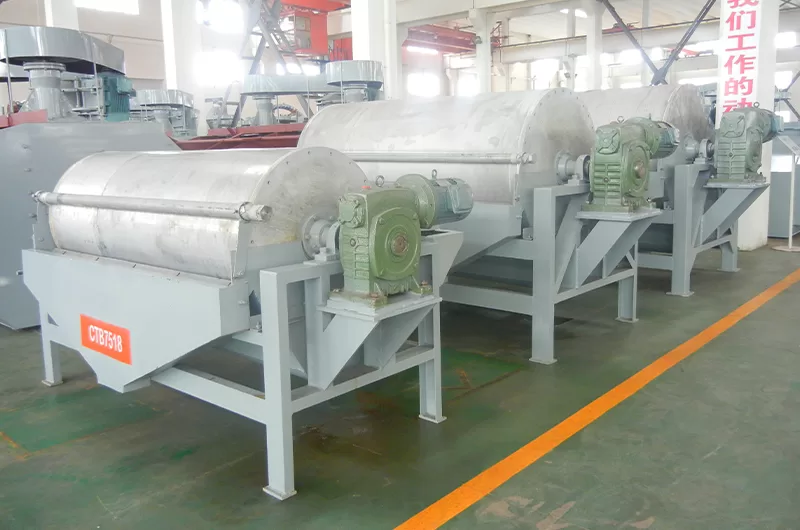Hematite vs. Magnetite: The 5 Key Differences Explained
Iron ore is the backbone of modern industry. As a key supplier of mining equipment, I know how important it is to understand your raw material. The most common iron ores are hematite and magnetite. While both provide the iron vital for steel, they are distinct. At ZONEDING, we have seen that properly identifying and understanding these two ores is critical for successful mining and processing. This guide explains the 5 key differences between hematite and magnetite. It gives you the knowledge to make smart decisions for your iron ore project.
Table of Contents
What is Hematite?
Hematite is a widely common iron oxide mineral. Its name comes from the Greek word “haima,” meaning blood, due to its reddish color.
- Composition: Hematite’s chemical formula is Fe₂O₃. This means it is made of two iron atoms combined with three oxygen atoms. Pure hematite can contain up to 70% iron by weight. It is a fantastic source of iron for steelmaking.
- Properties: Hematite is well-known for its distinctive red-brown streak. This is true even if the mineral itself appears silvery-gray. It is non-magnetic. You cannot pick it up with a magnet. Its hardness is between 5 and 6.5 on the Mohs scale. This means it is tough but still workable with mining equipment.
- Formation: Most hematite forms through the oxidation of other iron minerals. It also forms in large sedimentary deposits. These often come from ancient seas where iron in the water reacted with oxygen.
- Deposits: Significant hematite deposits are found in Banded Iron Formations (BIFs). These are ancient rock units that formed billions of years ago. Important deposits are in Australia, Brazil, and parts of North America. These deposits are often massive and near the surface.
- Uses: Hematite is a primary source of iron for steel production. High-grade hematite can be processed as Direct Shipping Ore (DSO). This means it needs less beneficiation before going to the steel mill. Lower-grade hematite needs more complex processing. This involves crushing, grinding, and separation.
What is Magnetite?
Magnetite is another important iron oxide mineral. It is famous for its strong magnetic properties.
- Composition: Magnetite’s chemical formula is Fe₃O₄. This means it has three iron atoms and four oxygen atoms. Pure magnetite typically contains about 72.4% iron. This is slightly higher than pure hematite. However, its overall grade in the ground can vary greatly.
- Properties: Magnetite is usually black or dark brown. It has a metallic luster. Its streak is black. The most crucial property is its strong magnetism. A standard magnet can easily pick up magnetite particles. Its hardness is between 5.5 and 6.5 on the Mohs scale. This is similar to hematite.
- Formation: Magnetite often forms in igneous and metamorphic rocks. It also forms from hydrothermal processes. It is common in intrusive igneous bodies and contact metamorphic zones.
- Deposits: Large magnetite deposits are found globally. Major ones are in Canada, Sweden, Russia, and the United States. These deposits often require hard rock mining techniques.
- Uses: Magnetite is a valuable iron ore. Due to its magnetic properties, it is well-suited for magnetic separation. This beneficiation process concentrates the iron. It produces a very high-purity iron concentrate. This concentrate is ideal for steelmaking. It is also used as a heavy aggregate and in some pigment applications.
5 Key Differences Between Hematite and Magnetite
Understanding these differences is crucial for choosing the right mining methods and processing equipment. It drives your project’s profitability.
Magnetic Properties
- Hematite: Is non-magnetic. It does not respond to a magnet.
- Magnetite: Is strongly magnetic. A simple magnet test is the easiest way to identify it. This difference directly impacts beneficiation. Magnetite is perfect for magnetic separation. Hematite needs other methods.
Chemical Composition and Theoretical Iron Content
- Hematite (Fe₂O₃): Contains up to 70% iron in its pure form.
- Magnetite (Fe₃O₄): Contains up to 72.4% iron in its pure form.
While magnetite has a slightly higher theoretical iron content, the actual iron grade in the mined ore can vary widely for both. It depends on how much waste rock (gangue) is present.
Color and Streak
- Hematite: Can appear silvery-gray, reddish-brown, or black. But its streak (the color it leaves when rubbed on unglazed porcelain) is always reddish-brown.
- Magnetite: Is typically black or dark brown. Its streak is always black. This is a very reliable field test.
Processing Methods
- Hematite: Processing often involves gravity separation, flotation, or a combination. Since it is not magnetic, these methods physically separate the iron. ZONEDING provides robust crushers and grinding mills to liberate hematite efficiently.
- Magnetite: Is primarily processed using magnetic separators. These machines use strong magnetic fields to pull the magnetite away from the non-magnetic gangue. This process is often simpler and more energy-efficient for magnetite.
- Hematite: Predominantly found in sedimentary Banded Iron Formations (BIFs). These tend to be vast, layered deposits.
- Magnetite: Often occurs in igneous and metamorphic rocks. It forms in different geological environments, sometimes as vein deposits or in disseminated forms.
Mistakes in Identifying Hematite and Magnetite
Misidentifying your iron ore can lead to costly errors in your mining and processing strategy.
- Relying on Color Alone: Some hematite can appear black (specular hematite), much like magnetite. Conversely, magnetite can sometimes have reddish stains from weathering. Relying only on visual color can be misleading.
- Ignoring the Streak Test: The streak test is simple yet powerful. Always perform it. A red-brown streak means hematite. A black streak means magnetite. This is a tell-tale sign.
- Not Using a Magnet: For anything that looks like magnetite, test it with a magnet. If it sticks, it is magnetite. If it does not, you are likely dealing with hematite or another non-magnetic iron mineral.
- Assuming Purity: Ore often comes mixed. You might have deposits containing both hematite and magnetite. Or impurities can mask the properties of the main mineral. Thorough testing is always needed.
- Fine Particle Confusion: In finely crushed or powdered form, visual differences can be very subtle. This makes simple identification harder without a magnet or streak plate.
Common Methods to Distinguish Hematite from Magnetite?
Field identification is quick and easy. Laboratory methods provide exact results.
- Magnet Test: This is the quickest and easiest way. Simply hold a small magnet near the sample. If the sample is attracted to the magnet, it is magnetite. If there is no attraction, it is likely hematite. Carry a strong magnet with you in the field.
- Streak Test: Rub the mineral vigorously across an unglazed porcelain streak plate.This test is reliable regardless of the mineral’s external color.
- Hematite will leave a characteristic red-brown streak.
- Magnetite will leave a black streak.
- Hardness Test: Use a set of Mohs hardness picks. Magnetite (5.5-6.5) is slightly harder than hematite (5-6.5), but there is overlap. So, this test is less definitive than the magnet or streak test.
- Chemical Analysis (Lab): For precise identification, a chemical assay in a lab can determine the exact Fe₂O₃ and Fe₃O₄ content. This provides the most accurate data for complex ores.
- X-ray Diffraction (XRD) and Microscopy: These advanced lab techniques can identify mineral phases. They reveal the crystal structure of the mineral. This gives a definitive answer for mineralogists.
Tips on Mining and Processing Hematite and Magnetite
Handling these two ores requires different approaches. Your equipment choices are key.
- Mining Strategy:
- Blasting: Both ores require effective blasting to break the rock. The specific geological conditions of your deposit will dictate your blasting pattern. Proper fragmentation is important for efficient crushing.
- Haulage: Once blasted, the ore is loaded into trucks. It is carried to the primary crusher.
- Pre-Concentration: For some hematite deposits, pre-concentration might remove barren waste rock before full processing. This reduces the amount of material you move. This saves on energy and costs.
- Processing Hematite:
- Crushing: Hematite generally requires robust crushing to reduce the run-of-mine (ROM) ore to a manageable size. ZONEDING’s jaw crushers are ideal for primary crushing tough hematite ore. These are often followed by cone crushers for secondary and tertiary crushing.
- Grinding: After crushing, hematite ores often need to be ground fine to liberate the iron minerals from the gangue. Our heavy-duty ball mills are designed for efficient fine grinding.
- Beneficiation: Since hematite is non-magnetic, gravity separation (like spirals or jigs) and flotation are common methods. These exploit differences in density or surface properties to separate the hematite.
- Processing Magnetite:
- Crushing & Grinding: Magnetite also needs crushing and grinding. However, it often requires finer grinding to achieve good liberation. This is because magnetite is frequently finely disseminated within the host rock. Our ZONEDING primary crushers are built tough for these abrasive ores.
- Beneficiation: The strong magnetic properties of magnetite make magnetic separation the preferred method. This is highly efficient. It produces a very high-grade concentrate. Low-intensity magnetic separators (LIMS) are used for coarser fractions. High-intensity magnetic separators (HIMS) are used for finer particles. ZONEDING offers reliable magnetic separation equipment tailored for magnetite recovery.
What Are Equipment When Processing Them?
The ZONEDING product range covers much of what you need for both.
- For Crushing (Both Hematite and Magnetite):
- Jaw Crushers: Used for primary crushing large ROM ore. These machines break down the biggest rocks.
- Cone Crushers: Used for secondary and tertiary crushing. They produce finer, more consistent material.
- Impact Crushers: Can be used for certain types of ore, especially for softer or less abrasive materials.
- For Grinding (Both Hematite and Magnetite):
- Ball Mills: Essential for fine grinding of crushed ore. They prepare the ore for downstream separation processes.
- Rod Mills: Sometimes used for coarser grinding stages.
- For Screening and Conveying (Both Hematite and Magnetite):
- Vibrating Screens: Used to separate different size fractions of crushed or ground ore. This ensures efficient processing at each stage.
- Belt Conveyors: Transport material throughout the processing plant. They are the arteries of your operation.
- Specific for Hematite Beneficiation:
- Spiral Concentrators: Use gravity to separate denser hematite from lighter gangue.
- Jig Separators: Another form of gravity separation.
- Flotation Cells: Used for finely disseminated hematite, employing chemical reagents to separate minerals.
- Specific for Magnetite Beneficiation:
- Magnetic Separators: The core equipment for magnetite processing. These use magnets to pull the iron-rich particles away from waste. They are highly efficient.
Selecting Equipment: How to Match Your Machinery to Your Ore?
Choosing the right equipment is not a guess; it is a science. At ZONEDING, we always emphasize the right match.
- Comprehensive Ore Testing: This is the most crucial step. You need a detailed metallurgical analysis of your specific ore body. This includes:
- Mineralogy: What minerals are present? What are their ratios?
- Iron Content: How much iron is there? What form is it in (hematite, magnetite, or mixed)?
- Hardness and Abrasiveness: How tough is the rock? This guides your choice of crusher capacity calculation and wear parts.
- Liberation Size: How fine do you need to grind the ore to separate the iron from the waste? This determines your grinding circuit design.
- Required Capacity: How many tons per hour (TPH) do you need to process? This will scale your crusher and mill sizes. Desired Product Quality: What is the target iron content and impurity level for your final concentrate? This dictates the complexity of your beneficiation circuit. Operational Costs: Consider power consumption, water usage, and wear part replacement. ZONEDING’s engineers can help you estimate these costs for different equipment configurations. We help optimize the operational cost of a jaw crusher or any other primary crushing solution. Site Conditions: Consider power availability, water access, and environmental regulations.
What Critical Data Do You Need Before Investing in an Iron Ore Project?
Before investing, you need critical data.
- Geological Data: Detailed maps, drilling results, and resource estimates.
- Mineralogical Studies: Precise identification of iron minerals (hematite, magnetite, etc.) and associated gangue.
- Metallurgical Test Work: This is crucial. It tests different processing routes on your specific ore. It determines liberation size, recovery rates, and concentrate quality.
- Market Analysis: What are the demand and price for your anticipated iron concentrate?
- Environmental Impact Assessment: Understanding and mitigating environmental risks.
- Economic Feasibility Study: Detailed CAPEX (capital expenditure) and OPEX (operational expenditure) projections.
FAQ
- What Are the Mining Challenges Unique to Each Iron Ore Type?
- Iron ore mining challenges differ based on the ore type. Hematite deposits in Banded Iron Formations are often massive. They are mined using large-scale open-pit methods. Challenges include managing large volumes of material and ensuring consistency. Magnetite deposits, often in harder igneous or metamorphic rock, can be more challenging to drill and blast. This means higher drilling and blasting costs. The finely disseminated nature of magnetite also means you need effective fine grinding equipment.
- How Do Separation Methods Differ for Hematite and Magnetite?
- Separation methods differ greatly. Magnetite is separated using various types of magnetic separation iron ore equipment. These machines simply pull the magnetic magnetite from non-magnetic waste. This is typically straightforward. Hematite, being non-magnetic, requires gravity separation (like spirals or jigs) or froth flotation. These methods are generally more complex. They often use more water and chemical reagents.
- Is One Ore More Cost-Effective to Process into Usable Iron?
- It depends very much on the specific deposit. Magnetite processing is often simpler in terms of flow sheet design because of magnetic separation’s efficiency. However, magnetite usually requires energy-intensive fine grinding to liberate the minerals. This can raise power costs. High-grade hematite as DSO is very cost-effective. But low-grade hematite processing, with complex gravity or flotation circuits, can be more expensive. A full economic analysis of your specific orebody is always needed.
Conclusion and Final Advice
Understanding the fundamental differences between hematite and magnetite is not just academic. It is essential for the economic success of any iron ore project. From initial exploration to final beneficiation, every decision you make should reflect the unique properties of your ore. Knowing your iron ore selection parameters allows you to choose the right mining techniques, select the most efficient processing equipment, and ultimately optimize your production costs.
Do not guess about your ore. Invest in thorough testing. Partner with experienced providers who understand the nuances of iron ore processing. This careful planning will ensure you build a robust and profitable operation.

